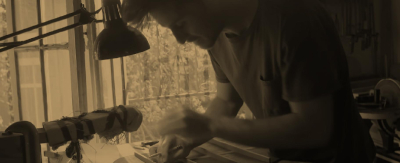Jean-Noël Rohé: Article, taken from the French magazine Guitare Classique, 2004
ALL SET FOR WORK
On Friday the 23rd of January 2004, the board of the 22nd competitive examination “One of the Finest Guitar Makers in France” (Un des Meilleurs Ouvriers de France, spécialité lutherie-guitare), chaired by Daniel Friederich, gathered in the Cité de la Musique, in Paris and awarded the title “the Finest Craftsman in France” (Meilleur Ouvrier de France – M.O.F.) to a few craftsmen, who had presented their work. Twenty nine candidates had enrolled at the end of 2002. Only twelve of them made it through to the end of the exercise, which consisted in making a very high quality concert instrument by meeting very strict technical and aesthetic standards. Just before the start of the competition, the candidates were aware that they were not necessarily going to be awarded, or that only one or at the most two candidates would receive an award. This year was truly exceptional considering that three guitar makers received awards for the excellence of their work. It had nothing to do with the board being particularly lenient for the eightieth year of the competitive examination. Seemingly, our guitar makers had simply excelled in their craft.
An old institution, still in fashion
What is this competitive examination all about exactly? We have all come across the expression “the Finest Craftsman in France” (FCF, Meilleur Ouvrier de France) behind a chocolate makers shop window or a baker’s counter, without really knowing what it corresponds to. A guarantee of quality, most certainly, but what else? Lucien Klotz, an art critic and journalist, is the founding father of this FCF competitive examination. He was concerned about the situation of craftsmanship and art, at the beginning of the 20thCentury. Lucien Klotz committed himself to the defence of what was still to be named the “cultural exception”. Among other things, he was the initiator of the laws relative to intellectual or scientific property, which are still in force. But the spearhead of Lucien Klotz just before the First World War was to restore the prestige of the art industry. As soon as 1913, he alerted the public opinion by stating that: “art professions are going through a worrying crisis. What are the causes? The most serious is the stagnation of apprenticeship. There is no longer any emulation. Manual production is anonymous. There is a remedy: you have to give the craftsmen’s personality back to them; so that a seat maker can one day receive the highest awards”. This statement is still valid today and it explains why the competitive examination has maintained its freshness in an era of globalisation and massive scale relocations. The competitive examination was really only established six years after the end of the Great War, in 1924. In the meantime, Lucien Klotz did not stop working. From conferences to newspaper articles, he increased public and political awareness on the essential quality of the exhibition, which was designed to present the works of craftsmen, in various fields and then selected them through competitive examination. Of course, only a few of them were honoured and this only represented a very minor part of their economic activity, as now. However, the spirit of this competitive examination lies in sustaining and passing on a certain statecraft, an expertise and an art that may well fall into oblivion, if not encouraged. The eligibility requirements are defined by the rules of the competitive examination. The candidates are allowed slightly more than a year to prepare their masterpiece. The latter is an exceptional achievement, which has often nothing to do with their day-to-day activity. For string instrument making, the rules of the game are slightly different. The point is to make a playable concert instrument, not a masterpiece, a museum piece or an instrument, where inventiveness competes against revolutionary form.
The exception which proves the rule
The competitive examination recognizes the expertise and the exceptional talent of its craftsmen, regardless of their initial training, background and the techniques they use. The result is what counts. This year, the three guitar makers were the exceptions who proved the rule. Yvon Le Moing, who is self-taught, made byroads into guitar making. Hervé Lahoun is an inspired young man, half poet, half guitar maker, who decided to take his bass guitar to pieces, one day, because it did not sound right. And Jean-Noël Rohé, who received an award at the prime age of 27 and for whom guitar making was just an obvious career choice. But what do they all have in common? Nothing, apart from their shared enthusiasm for a demanding craft that does not suffer from dilettantism or approximation. Nothing, apart from the fact that they ended up making a guitar at the same time, while abiding to strict criteria, in order to be recognized as the Finest Craftsman in France by their peers.
The rules of the competitive examination encompass everything or almost. The candidates have to present a concert instrument with strings, which is ready to be played. The dimensions, the weight and the essential oils are meticulously taken into consideration. It consists of a western cedar or spruce soundboard, a rosewood back, rosewood ribs and an ebony fingerboard and its total weight ranges from 1.5 kg to 1.85 kg. The candidates have some leeway as far as the rosette and the headstock are concerned, although the rules specify that it is preferable to present a work “devoid of decorative eccentricity” and that it is best to avoid “the mixture of excessive colors for the bindings and the design of the rosette”. Also, they can either use a pistol or a stamp for the varnish. How can they express their creativity when they have to respect such strict rules? Yvon Le Moing answers that it was not all that difficult for him: “what I usually do is not all that far off from these standards. We are given a certain leeway as far as the design, the form and the decoration of the guitar are concerned”. Jean-Noël Rohé did not think there were any constraints in these rules: “after all, what we are asked to make for the competitive examination corresponds to a concert guitar.”
Jean-Noël Rohé
The way Jean-Noël Rohé likes to put it is that guitar making as well as classical guitars appeared to him as the obvious choice. Determined and tenacious, he gave up his graphic communication studies at the age of 21, to dedicate himself to guitar making. He gathered information and sought the advice of a guitar maker, who warned him about the difficulties and the demanding nature of the craft. But Jean-Noël Rohé had found his career path. Guitar making is what he had decided he would do and indeed it is a guitar maker he has become. Across the channel, he learned his craft at the Newark School of Musical Instrument Making. Did this training in England give him a different perspective from his colleagues? “I think it is difficult, today, to talk of guitar making schools, the guitar seems to be an instrument without borders, made for travelling. Each guitar maker has his own particular way of conceiving his craft. It is wrong to think that musical instrument making is a purely technical craft. The maker’s sensitivity shows through his instruments. My professor, Tony Johnson, was fascinated by the extent to which the work of his students mirrored their personality. Therefore, I try to develop my own identity and conceive my work in my own way.” At only 27 years of age, Jean-Noël Rohé was awarded the title of “One of the Finest Craftsmen in France”. Many people would use this as something to boast about. But, he has kept a cool head: “To have been awarded by guitar makers, whom I respect, gives me a lot of energy for the future. However, I am aware that this in not at all the end of the journey. I will almost certainly never be completely satisfied by my work and this is, I think, what allows me to evolve.” As a reflective young man, he is aware that in guitar making, perhaps more than anything else, nothing can be taken for granted and nothing is final. Style-conscious about the slightest detail and interested in new materials, he now wants to try and work on the CSA rosewood “just to see what it’s like”. What is his career plan? He does not have one apart from the determined desire to do even better each time.
0 comment







